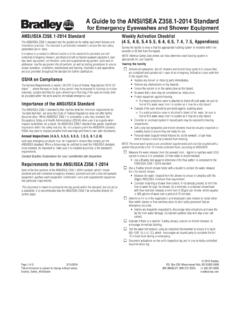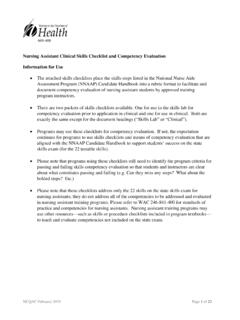Transcription of ANSI/ISEA Z358.1-2014 - Bradley Corp
1 ANSI/ISEA Compliance Information About ComplianceThe Code of Federal Regulations 29 CFR states: Where the eyes or body of any person may be exposed to injurious or corrosive materials, suitable facilities for quick drenching or flushing of the eyes and body shall be provided within the work area for immediate emergency use. The American National Standards Institute ( ansi ) establishes standards for minimum performance and use requirements for eyewash and shower equipment. The ANSI/ISEA for Emergency Eyewash and Shower Equipment provides detailed guidelines to which the Occupational Safety and Health Administration (OSHA), State OSHA and other regulatory agencies commonly Joint Commission 2009 EC Standard for Hospitals requires: The hospital takes action to minimize or eliminate identified safety and security risks in the physical environment.
2 Furthermore, hospitals are required to Minimize risk associated with selecting, handling, storing, transporting, using, and disposing hazardous chemicals. Surveyors commonly refer to OSHA requirements and the ansi Standard for further guidance on best demonstrated Provincial authorities also typically refer to ansi standards when auditing for or advising proper requirements for emergency eyewash ConsiderationsPersonal Wash UnitANSI standards allow a personal wash unit (ie. Bottled Eyewash) to be used as a supplement to the compliant ANSI/ISEA fixtures outlined in this guide. While supplemental fixtures (single head drench hoses, bottle eyewash) serve an important function in highly toxic, hazardous environments, it is important to remember they do not provide the same protection as ansi compliant drench showers, eye or eye/ face washes .
3 (Appendix A1)First Aid Practices Prior to the occurrence of an accident, consult with a physician or other professional for guidance in regards to common and specific work place hazards that may be present in your facility. Refer to Safety Data Sheets (SDS) for specific type of flush required (eyewash, eye/face or combination drench) given the hazards in the environment. Provide access to a physician or other medical professional immediately after an accident occurs. (Appendix A2)Waste Disposal Few consider the ramifications of hundreds of gallons of pooling flushing fluid in the area surrounding drench showers and eyewashes. It s important to have a plan in place for the disposal of the flushing fluid, whether one opts for the installation of drains in new construction facilities or dedicated waste containment systems.
4 Pooling fluid creates slip hazards, and presents a safety risk to an impaired worker. When planning for the disposal of flushing fluid, consult your local ordinances and governing authorities. (Appendix A3)Personal Protective Equipment Providing employees with personal protective equipment (safety glasses, protective suits, etc), in accordance with OSHA (a), is required. It can be challenging to enforce the use of that protection equipment at all times. ansi explicitly states that personal protective equipment does not replace the role of safety drench showers, eyewashes, and other safety flushing equipment. These fixtures are intended to treat injuries should PPE prove to be inadequate or fail. (Appendix A4)InstallationSupply linesEach manufacturer provides its own recommendations in regards to the supply size that s adequate for each fixture.
5 It s important to note that by reducing the size of the supply, the shower s ability to deliver the flushing fluid at the proper rate with the intended pattern is directly affected. (Appendix B1)Water CapacityCompliant safety showers and eyewashes are supplied with a minimum pressure of 30 psi (207 kPa). Typical facilities supply their fixtures with 45 psi (310 kPa) inlet supply pressure. Extra care should be taken with any pressure that exceeds 80 psi (552 kPa). Complicated site conditions often require the installation of fixtures a significant distance from the water supply. The owner and designer are responsible for ensuring that adequate pressure and flushing fluid will be delivered through the fixture even at low points of pressure. (Appendix B2)Valve OperationValves that remain open are required in order to allow the injured individual to maximize the use of their hands to disrobe and flush their eyes.
6 In limited circumstances, an inspector or other enforcing authority may allow a self-closing ball valve, in school-related laboratory environments, where the contaminant is not a serious threat. (Appendix B3)Alarm DevicesSystems that provide visual, audible and an auxiliary connection serve as a great asset that discourages false activations, and allows medical personnel to locate where the accident occurred and respond rapidly. (Appendix B4)Placement of Emergency EquipmentSafety drench showers, eye and eye/ face washes must be within 10 seconds or 55 feet ( meters) of the hazard. Fixtures may not be blocked. A door is considered an obstruction. However, if the contaminant is not hazardous or corrosive, a single door may be present provided it opens in the same direction of travel.
7 The door may not have a locking mechanism, which may prevent the person access to use the equipment during an emergency. (Appendix B5)Delivered Flushing Fluid TemperatureLukewarm (tepid) water is required for the full 15 minute flush, for a drench shower, eye or eye/face wash. To encourage injured personnel to continue to flush the entire 15 minutes or longer as needed, the ANSI/ISEA standard indicates that tepid water is required. Tepid is defined as 60-100 F ( C). Prolonged exposure to near freezing water has been proven to affect the body s ability to maintain body temperature, increasing the risk of hypothermia. Whenever possible, consult a physician to determine the recommended temperature based on specific types hazardous chemicals or material. (Appendix B6)Weekly ActivationEmergency Drench Showers, Eye and Eye/ face washes must be activated one time per week.
8 This activation ensures that nothing is blocking the flow of the flushing fluid and eliminates any chance of contamination from stagnant water. (Appendix B7)This guide serves as a supplement to the ANSI/ISEA Compliance GuideFREE Confidential Safety Evaluation Drench Showers Valve mechanism opens in one second or less; it stays open until manually closed. (Section ) Supply with flushing fluid ("potable water, preserved water, preserved buffered saline solution or other medically acceptable "). (Definitions, Sections , ) Locate 10 seconds or 55' ( m) from contaminants or hazardous materials. Locate on the same plane as hazard and free of obstructions. (Section , Appendix B5) Doors are an obstruction. (Appendix B5) Must resist corrosion in the presence of flushing fluid.
9 (Section ) Audible, visual and central control alarm systems deter vandals and notify personnel that an accident occurred. (Appendix B4) Environmental conditions often require freeze or scald protection equipment. (Section )Top down viewRequires a 16" (406 mm) radius from the center of the drench shower spray pattern to be free of obstructions. (Section ) 15-minute FlushTepid WaterThird-Party CertificationsWeekly Activations:Annual Inspections Compliant showers release a continuous flow of at least 20 GPM (76 L-MIN) of tepid flushing fluid for a period of at least 15 minutes. (Sections , , , )(lukewarm) 60 100 F ( C) encourages full 15 minute flush or until medical personnel arrive. (Definitions, Sections , Appendix B6)Manufacturers may have their safety fixtures independently evaluated by a third-party testing organization.
10 Look for certification when selecting a compliant fixture. (Definitions)Flush lines and test by activating weekly. Inspection tags are often included with fixtures to document testing and to satisfy a safety audit. (Section ) ansi recommends a comprehensive annual inspection of the facility to evaluate modified work space, assess new hazards introduced into the area, and to identify fixtures needing replacement or repair. (Section )69" (1752 mm)(Sections , 7)60" (1524 mm)(Sections , 7)Spray PatternDiameter20" (508 mm)(Section , 7)82 96" (2083 2438 mm)(Sections , 7)16" (406 mm)(Sections , 7) Combination Drench Shower, Eye and Eye/ face washes Valve mechanism opens in one second or less; it stays open until manually closed. (Sections , , , , , ) Drench shower and eye or eye/face wash must operate simultaneously.














